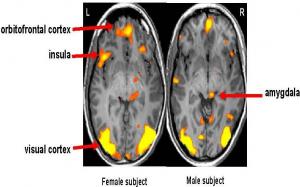Face Perception Is Modulated
By Sexual OrientationFace perception evokes activation in a distributed cortical network that includes visual, limbic and prefontal regions. Shown are two axial slices, taken from the brain of two individuals. Regardless of gender, both subjects exhibited virtually identical patterns of response to male and female faces. The only region that showed differential response to sexually relevant faces is the orbitofrontal cortex: heterosexual women and homosexual men responded more to male faces, whereas heterosexual men and homosexual women responded more to female faces. Yellow indicates highly significant activation. (Image credit: Alumit Ishai)
New research indicates that an area of the brain thought to act in reward circuitry may represent a phase in visual processing during which sexual orientation modulates how we perceive individual faces. The findings are reported by Felicitas Kranz and Alumit Ishai of the University of Zurich.Of all the visual skills possessed by humans, face recognition is arguably the most developed. Past brain imaging studies have shown that the brain's cortical network for face perception includes regions in visual cortex that process the identification of individuals as well as social cues, such as gaze direction and speech-related movements; the amygdala and insula, where facial expressions are processed; and regions in prefrontal cortex and the reward circuitry, where the assessment of facial beauty is processed. Numerous studies have shown that the neural response to faces is modulated by cognitive factors such as familiarity, attention, memory, visual imagery, and emotion. For example, recent empirical evidence indicates that emotional faces (e.g., happy, fearful, or angry faces) evoke stronger neural activation than neutral faces, presumably as a result of their biological importance. It is currently unknown, however, whether the response to faces is modulated by gender or sexual orientation.
Social communication requires the accurate analysis of the intentions of other individuals. To this end, men and women likely adopt strategies of "face reading" in order to successfully interact with potential sexual partners. Thus, it is reasonable to assume differential patterns of activation in the hetero- and homosexual brains in response to faces of the same or opposite sex. In their new work, the researchers hypothesized that hetero- and homosexual subjects would exhibit a greater response to faces they deem sexually preferable. Specifically, the researchers predicted similar responses to male and female faces in the visual cortex, where facial identity is processed, but differential responses in the amygdala and the reward circuitry, where a "value" is assigned to faces. The researchers postulated that heterosexual women and homosexual men would show a greater response in these areas to male than to female faces, whereas heterosexual men and homosexual women would respond more to female than to male faces.
To test this hypothesis, the researchers used functional Magnetic Resonance Imaging (fMRI), a non-invasive technique that permits the localization of regions in the human brain activated during cognition and experience. The researchers scanned 40 subjects (10 heterosexual women, 10 heterosexual men, 10 homosexual women, 10 homosexual men, mean age 26 ± 3 years) that were classified as hetero- or homosexuals on the basis of their self-report. While in the MR scanner, the subjects either passively viewed faces or pressed one of three buttons to indicate whether a face was Attractive, Neutral, or Unattractive, and reaction times were recorded.
Behaviorally, regardless of their gender and sexual orientation, all subjects rated the attractiveness of both male and female faces very similarly, suggesting that men and women equally notice and respond to beauty of individuals of the same and opposite sexes. Interestingly, all subjects, regardless of their gender or sexual preference, also showed virtually identical patterns of neural activation in regions in the visual cortex and the limbic system, where male and female faces elicited responses of similar magnitude. The findings indicated that invariant (facial identity) and variant (facial expression) features are similarly processed in the brain, independent of the gender of the individual who is viewed or the sexual orientation of the viewer.
The researchers found that, consistent with their hypothesis, the gender of a viewed individual, when the sexual preference of the viewer was taken into account, did make a difference in the reactions seen in the thalamus and the orbitofrontal cortex, a region of the brain's reward circuitry. Heterosexual women and homosexual men exhibited a significantly greater response to male faces, whereas heterosexual men and homosexual women responded significantly more to female faces.
The orbitofrontal cortex is known to be involved in representing the reward value of various sensory stimuli, including beautiful faces, as well as the reward value of abstract positive (for example, money) and negative (for example, punishment) entities. What could this mean for interpreting socially relevant information? Past work has shown that patients with lesions in orbitofrontal cortex are impaired in their ability to identify emotional facial expressions, suggesting that this region has an important role in the processing of facial cues required for social communication. In this light, the researchers suggest that the observed modulation by sexual preference of the response to faces within the orbitofrontal cortex extends the role of this brain region in social behavior.
Does the orbitofrontal cortex play a role in evaluating potential reproductive partners? Facial beauty is considered a marker for reproductive fitness. Not surprisingly, recent studies have reported that facial beauty evokes activation in the brain's reward circuitry. It has been suggested that the rewarding, evolutionarily adaptive value of an attractive face can be dissociated from its aesthetic value: for example, an attractive opposite-sex face may signal that a potential sexual partner has a healthy genotype, but an attractive, same-sex face cannot indicate such reproductive benefits. The orbitofrontal cortex could therefore mediate the evolutionary, adaptive value of attractive, opposite-sex faces, thus providing putative neural correlates for the assessment of potential mates for reproductive purposes. However, the researchers in fact did not find neural evidence in support of such dissociation between attractive faces of the opposite sex, reflecting reproductive benefits, and attractive faces of the same sex, reflecting aesthetic appraisal of beauty. Rather, the researchers' findings indicated that the orbitofrontal cortex has a more general role in representing the reward value of faces of potential sexual partners, including same-sex mates, irrespective of reproduction.
The findings suggest that the response to faces in the reward circuitry is modulated by sexual preference, and they provide neural evidence for the role of face processing in mating.

